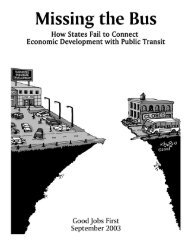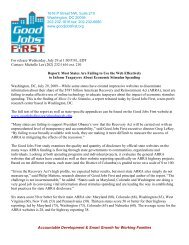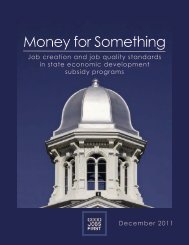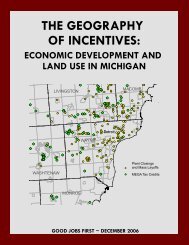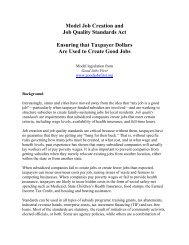Subsidizing the Low Road: Economic ... - Good Jobs First
Subsidizing the Low Road: Economic ... - Good Jobs First
Subsidizing the Low Road: Economic ... - Good Jobs First
Create successful ePaper yourself
Turn your PDF publications into a flip-book with our unique Google optimized e-Paper software.
10. ConclusionBaltimore’s massive investment in <strong>the</strong> Inner Harbor and downtown reveals arecurring history of high costs, low benefits, and a lack of safeguards to ensure thattaxpayer investments really pay off in family-wage jobs and an enhanced tax base.Unlike most states and many big cities, Baltimore has no job quality standards, or lawsrequiring subsidized companies to pay a certain wage or to provide healthcare. Thepattern is especially troubling today, because instead of federal or state dollars tofinance development deals, <strong>the</strong> city increasingly employs local tax expenditures – TIFand PILOTS – which mean foregone future revenues for education, infrastructure ando<strong>the</strong>r public services.Baltimore development efforts are also marred by pervasive process problems.Baltimore’s privatized system for initiating deals – through <strong>the</strong> Baltimore DevelopmentCorporation (BDC) – affords taxpayers no opportunity for input as deals are shaped,and often only perfunctory chances to analyze or comment before <strong>the</strong>y are formallyauthorized by <strong>the</strong> Board of Estimates or <strong>the</strong> City Council. The BDC’s records are secret,exempted from <strong>the</strong> Maryland Public Information Act. More broadly, citizenorganizations have few meaningful ways to engage in and influence long-term prioritysetting.Citizen participation is also discouraged by budget reporting systems thatmake <strong>the</strong> city’s economic development spending difficult to discern.To address <strong>the</strong> shortcomings found in our analysis, we offer policy options:Enhance Public Participation. The city can enhance public participation in <strong>the</strong> economicdevelopment process in several ways:• Reducing <strong>the</strong> Board of Estimates, which approves most economic developmentsubsidies, to its three elected officials (<strong>the</strong> Mayor, <strong>the</strong> Comptroller, and <strong>the</strong> CityCouncil President);• Requiring that a public hearing be held to discuss each proposed subsidy withnotice given at least 30 days in advance of <strong>the</strong> hearing. Information on <strong>the</strong> dealwould also be made available to <strong>the</strong> public 30 days in advance. This informationwould include <strong>the</strong> location and scope of <strong>the</strong> project, <strong>the</strong> value of <strong>the</strong> subsidy,<strong>the</strong> projected jobs created or retained by <strong>the</strong> project, <strong>the</strong> projected wage andbenefit levels of <strong>the</strong> jobs, <strong>the</strong> projected tax revenues, an analysis that explainswhy <strong>the</strong> subsidy is necessary and any o<strong>the</strong>r relevant economic analysesperformed by <strong>the</strong> economic development agency;50



